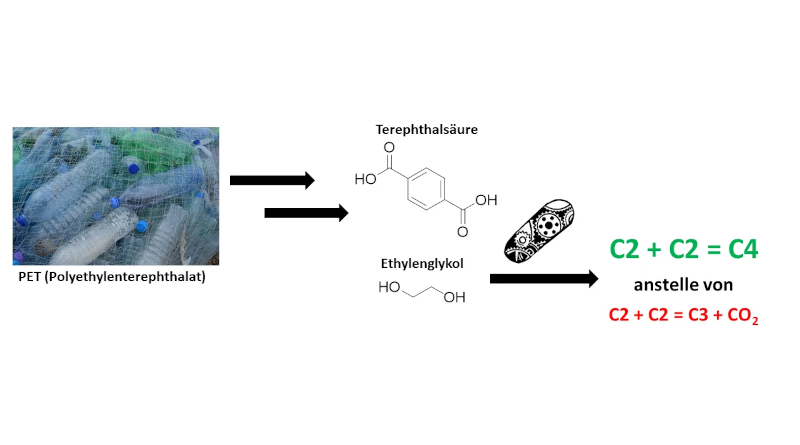Recycling through bacteria
Scientists from the Max Planck Institute in Marburg, Germany, have developed an efficient and carbon dioxide-saving pathway for the bacterial conversion of ethylene glycol, a component of the plastic PET. They equipped the bacterium Pseudomonas putida with a new metabolic pathway discovered in marine microbes, which led to improved growth. Their findings offer new opportunities for the microbial degradation of PET, as well as the development of sustainable material cycles.
Since the discovery of the “PET-eating” bacterium Ideonella sakaiensis in 2016, many studies have focused on PET. The basic building block of PET, the C2 molecule ethylene glycol, is also used as antifreeze or solvent. Additionally, it can be electrochemically produced from syngas, making it a key component of future carbon-neutral biotechnologies. Therefore, the development of bacterial strains with improved ethylene glycol conversion is important not only for the upcycling of PET but also in the larger context of creating sustainable industrial material cycles for this ubiquitous chemical.
Scientists from the Max Planck Institute for Terrestrial Microbiology, the Max Planck Institute for Molecular Plant Physiology, and Leiden University have now achieved a crucial step towards sustainable material usage. By equipping the biotechnologically relevant bacterium Pseudomonas putida with a new metabolic pathway, they increased its capacity to process ethylene glycol.
The research team built on previous work, which discovered a metabolic pathway in marine microorganisms that efficiently converts C2 molecules, called the beta-hydroxyaspartate cycle (BHAC). Using synthetic biology and directed evolution methods, they successfully incorporated this pathway into the bacterium.
“The BHAC is an elegant metabolic cycle in which the carbon of ethylene glycol is recycled without releasing CO2. It is therefore much more preferable in terms of carbon and energy balance. With it, our newly developed bacterial strain can process the basic building block of PET much more efficiently,” says Lennart Schada von Borzyskowski, one of the lead authors and co-initiator of the study. He conducted his experiments as part of his postdoctoral research at the Max Planck Institute for Terrestrial Microbiology in Marburg and collaborated with the group of Arren Bar-Even at the Max Planck Institute for Molecular Plant Physiology in Golm.
Helena Schulz-Mirbach, co-author of the study, explains: “First, we demonstrated with selected E. coli strains that the synthetically modified bacteria are able to form the entire cellular biomass even after incorporating a BHAC fragment. After subsequent incorporation of the complete BHAC, the new P. putida strain was immediately able to grow on ethylene glycol. The incorporation also led to changes in the host’s central carbon metabolism. Thirdly, we were able to generate mutations through targeted laboratory evolution that further improved the growth of the modified strain on ethylene glycol – a 35% faster growth with a 20% increase in biomass.”
A new module for synthetic biology
“The development of sustainable material cycles is probably the greatest challenge of our time,” says Tobias Erb, Director at the Max Planck Institute for Terrestrial Microbiology and coordinator of the study. “Microbial plastic degradation without CO2 emissions is an important step towards a closed carbon cycle.”
“The study shows the high potential of the BHAC metabolic pathway as a ‘plug-and-play’ metabolic module for synthetic biology,” adds Lennart Schada von Borzyskowski, who is now a professor at Leiden University in the Netherlands. “Recently, we have started testing the BHAC in other organisms, such as the model plant Arabidopsis thaliana. Here, we were able to show that the BHAC makes plant photosynthesis more efficient by allowing the plant to retain more CO2. These results are very promising for research on CO2-saving metabolic pathways for biotechnology and agriculture.”
Photo: Researchers have developed a more efficient, carbon-dioxide-saving way to bacterially recycle ethylene glycol, a component of PET plastic. Their “cell factories” offer new opportunities for the microbial degradation of PET (Source: Max Planck Institute for Terrestrial Microbiology/Schada von Borzyskowski & Erb)

